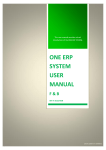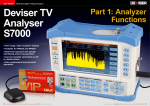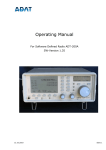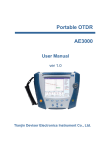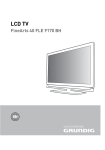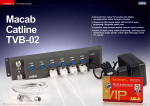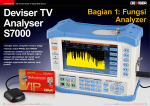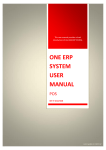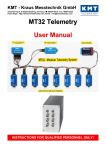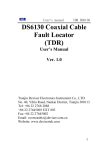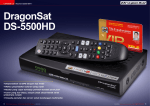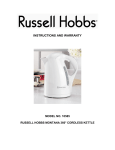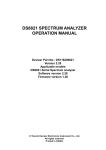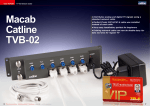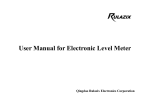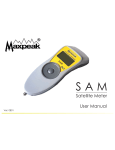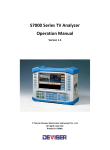Download deviser ds2400t - TELE
Transcript
TEST REPORT Digital TV Meter DEVISER DS2400T •offers all measuring options a professional antenna installer needs •among the highlights are MER measurements for each transponder, ground loop measurements and a remote measurement function •excellent user interface and top-notch software features •display with extremely high resolution, perfectly suitable for showing the spectrum and constellation diagrams •one of the bonus features is long-term measurement of BER 36 TELE-satellite International — The World‘s Largest Digital TV Trade Magazine — 09-10/2012 — www.TELE-satellite.com www.TELE-satellite.com — 09-10/2012 — TELE-satellite International — 全球发行量最大的数字电视杂志 37 TEST REPORT Digital TV Signal Meter Excellent Meter for Professionals in DVB-T, DVB-C and CATV (analog TV) We received the DS2400T in a rather plain cardboard box that featured the prominent Deviser logo. Safely packed inside was a good-looking protective bag made of nylon which can be used for storing the signal meter. There is enough space for the device itself and the power pack, and the bag even sports an outside pocket on one side which comes very handy for accessories such as the measuring cable or some socket adapters. Together with the meter and power pack you receive a special cable for hooking up the unit to a PC, as well as two 8cm mini CDs. One includes the driver software for the virtual serial interface that is used by the meter to establish a connection with the PC, while the second CD provides a PDF file with an Englishlanguage user manual and the DS2400 Toolbox software that is required to operate the meter directly from the PC. We’ll dig a little deeper with regard to that option in a moment. The signal meter is very compact in size and thus sits extremely comfortably in your hand. With the light blue colour so typical of Deviser products it not only feels good, but also looks rather unique. As far as weight is concerned it is ■ Of course we put the DS2400T to a real-world test right away. Here we use it to align a new DVB-T antenna. 09-10/2012 DEVISER DS2400T This is by far the best handheld measuring instrument for DVB-T, DVB-C and CATV I have come across. Deviser has done an excellent job! www.TELE-satellite.com/12/09/deviser ■ ECHO measurement with the new antenna. 38 TELE-satellite International — The World‘s Largest Digital TV Trade Magazine — 09-10/2012 — www.TELE-satellite.com www.TELE-satellite.com — 09-10/2012 — TELE-satellite International — 全球发行量最大的数字电视杂志 39 within the expected range and the rubber protection all around the DS2400T safeguards against damage when used outside and up on the roof. While the HF input is placed on the back panel of the device, USB input and power supply socket are located on the front panel. In addition, the front panel features a high-resolution TFT display and a total of 17 buttons below the screen. An 1 6 2 7 3 8 4 9 5 10 LED indicates the current status of the battery pack. All buttons are self-explanatory and provide a pleasant pressure point with just the right amount of feedback you need. The first row of buttons consists of the F1, F2 and F3 function keys whose currently active function is shown on the bottom line of the display. In the second row there is the HOME button that always brings you back to the main menu in an instant, as well as the UP and DOWN buttons for navigating between menu items. Below this row comes the numeric pad that is set up just like on phones, which means that each number can also be used to type three different letters (much like texting), so that you can easily enter names as well, for example. The last row of buttons features 1. Main menu of the DS2400T with twelve different measurement modes. 2. Level measurement: Results are displayed as numerical values and as a bar chart. Seen here is an analog transponder with simultaneous measurement of video and audio levels. The level is below a predefined threshold, hence the FAIL indication of the automatic quality check. 3. Signal strength measurement of a DVB-C transponder. Here too, the result is displayed as a numerical value and a bar chart. In addition, the meter shows MER, PRE-BER and POST-BER parameters. The automatic quality check gives the PASS mark. 4. The constellation diagram is greatly helped by the high-resolution TFT display. 5. Long-term BER measurement: As the signal in our test center is too good, the antenna cable was plugged off for a split second. The meter reacted swiftly and reliably. Long-term measurements are great for detecting occasional faults at a client’s system and for establishing a correlation with other events. 6. MER vs. carriers: This type of measurement is still not very common and shows the MER (Modulation Error Rate) of each carrier on a DVB-T transponder. This way it is possible to determine interference on individual carriers which results in occasional loss of video, even though the average MER looks fine. No other measurement is capable of identifying such problems. 7. The marker was moved to carrier no. 2155 in order to find out its specific MER. The DS2400T also offers a peak hold mode for such cases. 8. ECHO measurements are particularly important with SFN (Single Frequency Network) DVB-T networks, since a second time-delayed signal on the same frequency can easily cause reception problems. At our location, however, no echoes can be received even though we use a SFN. 9. The DS2400T is able to generate a very detailed spectrum. Seen here is the entire spectrum, with two markers available for measuring the signal level at two different positions and showing the difference between the two. 10. Speed is not the main point of this meter’s spectrum, but this is not an issue for DVB-T, DVB-C and CATV – contrary to DVB-S. Small frequency spans offer much more help, as they can visualise even individual carriers (and their problems) of the transponder. 40 TELE-satellite International — The World‘s Largest Digital TV Trade Magazine — 09-10/2012 — www.TELE-satellite.com the main switch to turn the meter on and off, as well as the ZERO button and the status LED. We should once again stress that we’re talking about a professional signal meter for antenna installers. Deviser is a major manufacturer for TV, CATV (analog TV), and satellite signal meters (for more information about Deviser please have a look at the company report in TELE- 11 16 12 17 satellite 06-07/2011), and as soon as you turn on the DS2400T for the first time you will notice that this is not a gadget for amateurs, but a top-notch tool for pros. It’s ready to use after only a few seconds, there are no colourful animations, and loading times are impressively short. All that pops up on the display is the model name DS2400T, followed after a short moment by the main menu. And what a main menu it is: No less than twelve different measurement modes are available, as well as dedicated menus for configuration and file management. The sheer number of distinct measurement options leaves no doubt that Deviser is very serious about its new DS2400T meter. To give you an impression of the power hidden inside this neat device we’ll look at all twelve modes below: Signal level/signal strength 13 14 15 18 19 20 The DS2400T makes a difference between analog and digital signals. For analog signals the meter shows numeric values for video and audio levels, as well as bars. The corresponding distance – commonly referred to as V/A ratio or video/audio ratio – is also indicated. This shows that Deviser has professional installers in mind, many of whom set up large-scale distribution systems in apartment buildings or hotels and who can see at a glance whether or not signal levels 11. Tilt measurements are required for the correct adjustment of signal amplifiers in cable networks, for example. The aim is to achieve similar signal levels for all channels. 12. With the DS2400T it is possible to select up to eight channels of the channel list for tilt measurement. 13. Bar search: Blue bars indicate digital channels, green/yellow bars indicate analog channels, with green showing the video level and yellow showing the corresponding audio level. 14. Ground loop measurement: Ground loops are caused within the power grid and interfere with analog channels. Depending on the power supply in place the meter can be set at 50Hz or 60Hz. 15. Result of threshold measurement: All pre-defined channels are measured and the result is then presented in a chart. If preferred, a graphic presentation of the result is possible as well. 16. Measurement of carrier/noise ratio: Again, this is relevant for analog channels. The DS2400T even shows the total bandwidth of the channels as a useful bonus. 17. Return channel: The spectrum shows the frequency range from 5MHz to 45MHz or – if required – 65MHz. 18. Configuration menu with user-friendly grouping of various parameters. 19. Information about the meter: Note that the most recent calibration date can also be called up at any time. 20. Users can set a period of inactivity, after which the meter automatically switches off in order to save valuable battery life. 42 TELE-satellite International — The World‘s Largest Digital TV Trade Magazine — 09-10/2012 — www.TELE-satellite.com are OK. The DS2400T offers an automatic signal quality check that either shows PASS or FAIL, depending on whether or not the measured signal reaches a predefined threshold level. If it’s a digital signal you’re analysing the display content changes and the signal strength is shown with numeric values and bars together with MER, PREBER and POST-BER parameters. Once again the built-in signal quality check will indicate PASS or FAIL, thus showing installers right away whether or not the signal in question is all right. Using the arrow buttons it is possible to navigate up and down the channel list, with the meter reacting very swiftly to new channels and displaying all corresponding signal data without significant delay. This is what we call true value for money, and what the DS2400T offers is much better than just PASS, it’s closer to pass with distinction! Constellation If your digital signal is error-prone and you need to find the root cause a constellation diagram can work wonders. If it turns out that signals are not located in the correct square field you get BIT errors. By looking at the concentration of dots within the cloud of dots in a constellation diagram you can find out how stable your reception is. If each square field comes with a relatively small and concise cloud of dots there’s nothing in the way of reliable reception. If the cloud covers a large and more or less uncontained area some dots may wander off into a wrong square field and impair the overall signal quality. Together with the constellation diagram the DS2400T also shows signal strength, MER, PRE-BER and POST-BER values, thanks to the high-resolution TFT display with its 320x200 pixels. It’s not only brilliant to read but also allows packing in a great deal of information and useful details without putting at risk usability. BER measurement ■ Thanks to a metal strap the meter can easily be fixed to equipment, so that both of your hands are free for installation jobs. BER measurement is used to find out the bit error rate, or in other words: how many faulty bits are received. There are a number of different DVB standards in place all around the world, and each comes with its own distinctive automatic error correction regime, which is called VITERBI. This correction routine makes sure that bit errors up to a certain threshold can be corrected without generating a faulty TV image. The threshold of bit errors lies between 10-5 und 107, depending on the DVB standard used. This means that one incorrect bit for every 10,000 to 1,000,000 correct bits will www.TELE-satellite.com — 09-10/2012 — TELE-satellite International — 全球发行量最大的数字电视杂志 43 21 ment modes we already looked at. When I called up MER measurement, however, I was simply at awe: At long last a manufacturer has come up with a convenient hand-held device that is able to perform long-term measurements which can actually be put to use by professionals. With the DS2400T users can define a period from one minute to several days during which the meter will collect all relevant data and then present the results in a way that is nothing short of extraordinary. The sheer amount of data does not compromise usability at all. What’s more, there is no need to connect the meter to a PC for long-term measurements. Installers can use this feature to even detect occasional image faults, something that is of enormous value and can only be found in professional equipment. be fine. Because of automatic VITERBI error correction BER measurements are frequently performed as two separate measurements: The first result shows bit 22 25 errors before automatic correction (PREBER), the second result indicates bit errors after correction (POST-BER). At first I was not entirely sure why there are separate menu items for BER and MER measurements, as both parameters are also shown in the measure- 28 M-GRAM measurement And that’s not all: It may sound too good to be true but the DS2400T is capable of measuring the MER (modulation error ratio) of individual carriers. Such a measurement is often referred to as ‘MER versus carriers’ and is particularly 31 23 26 29 32 24 27 30 33 44 TELE-satellite International — The World‘s Largest Digital TV Trade Magazine — 09-10/2012 — www.TELE-satellite.com important for DVB-T. While most meters only measure MER as the average across all active carriers, only very few can give separate results for each carrier of a DVB-T transponder. Why is this so important? In some scenarios a neighbouring analog transmitter might interfere with some – but not all – carriers of a digital transponder, since analog transmitters broadcast three relatively small frequency spaces for video, audio and colour. In such a case the average MER value may well look OK, even though reception is not possible because some carriers experience massive interference while the majority of carriers boast an excellent signal. Conventional measurements cannot identify such a problem, and you really require professional equipment such as the DS2400T to get to the heart of the matter. All you need to do is position a marker above individual carriers to find out the corresponding results of the MER measurement. Moreover, MER measurements have a peak hold function, which means the current MER value is shown in yellow, while the peak value is drawn with red colour. Too good to be true? Yes, but that’s what you should get used to with this meter. Again, this is a measurement that is particularly helpful for DVB-T signal analysis. A number of countries (including Portugal, our test location for this report) have opted to implement DVB-T as SFN (Single Frequency Network). The advantage of such an approach is that all broadcast cells use the same frequency so that reception equipment can have the same channel list irrespective of where it is used. Mobile reception benefits greatly, since you never need to perform a channel search while moving around within a country’s borders. On the other hand, all that glitters is not gold since single frequency networks cause different lag times in cases when a receiver is operated between two cells. In such a case two slightly time-delayed signals with the same frequency reach the receiver and cause interference that is called echo. DVB-T comes with an integrated correction mechanism that filters echoes up to a certain distance. That distance is referred to GUARD INTERVAL and echoes that are produced within the guard interval do not cause image interference, while echoes exceeding the guard interval will result in visible interference. 21. Language selection: English, Dutch, Turkish, Chinese 22. The DS2400T comes with an integrated clock that can be used to add a timestamp to each measurement. 23. Deviser has equipped the DS2400T with enough memory capacity to also deal with large-scale installations without the need for a PC. 24. Measuring units can be adjusted to meet personal requirements. 25. The DS2400T even allows user calibration, to make sure different meters used within a company all give out the same measurement results, for example. 26. Separate threshold values can be defined for DVB-T, CATV and DVB-C, which then flow into the automatic quality check. 29. The DS2400T comes with a built-in voltage checker which can measure the voltage arriving at the HF input. 30. What’s more, the current voltage of the internal battery pack can also be checked. 31. And for the curious among you, it is even possible to find out the inside temperature of the meter. 32. A number of different channel lists are pre-stored in the meter. 33. Each channel list can include both analog and digital channels. If you only want to measure analog or digital channels there is no need to set up additional channel lists. This is the menu item for channel list configuration/editing. Echo measurement www.TELE-satellite.com — 09-10/2012 — TELE-satellite International — 全球发行量最大的数字电视杂志 45 The DS2400T shines once again, delivering excellent ECHO measurements which are shown as a graphic as well as listed in a chart which also includes the signal strength and distance to cell given in km. Based on this information installers are able to optimise the alignment of the antenna. Spectrum analyzer Obviously the DS2400T comes with a spectrum analyzer function as well. Thanks to the high-resolution TFT display the spectrum is shown with great detail, something that is not usually the case with handheld meters. Frequency spans can be set in pre-defined steps of 2.5MHz, 6.25MHz, 12.5MHz, 25MHz and 62.5MHz or Full Band. These options alone speak volumes about Deviser’s target group, namely professional installers. It’s the small steps that come to the fore, as they are required to look at individual carriers of digital transponders. The vast amount of analysis that is involved causes the spectrum build-up to be on the slow side, but it is quite evident that the DS2400T spectrum analyzer is not for real-time antenna alignment, but much rather for detecting even the slightest interference. We also appreciated the option of freely positioning two markers anywhere in the spectrum in order to measure the C/N ratio. Tilt measurement For this measurement up to eight channels from the channel list are selected. They are then analysed and the results are presented as a bar graph. Among other things, this measurement can be used to set up antenna amplifiers, for example, so that all channels are distributed with the same signal level. We were truly impressed by the fact that you can perform a tilt measurement for up to eight channels with the DS2400T. Bar search This is another very popular measurement option that is useful for cable networks. Instead of measuring the entire spectrum only the channels on the channel list are evaluated and the individual results are shown as a bar graph in 1. The Toolbox software for the DS2400T meter has a modern look and feel, and offers a user-friendly structure. Even though the product is shipped with a comprehensive user manual written in brilliant English you will most probably find out everything you need to know without it. A number of measurements can be performed directly on the PC in real time if you connect the DS2400T with the supplied adapter cable. In this example the selected frequency is measured continuously. 2. The spectrum can be displayed directly on the PC as well. This makes the DS2400T a perfect fit for remote monitoring of a system thanks to Windows Remote Desktop Protocol. 3. Bar search with digital and analog channels. The audio level of analog channels is shown in yellow. 4. Tilt measurement: Easy to use and fast – right from the PC. There even is an interpolated line giving an indication of tilt! 1 2 3 4 46 TELE-satellite International — The World‘s Largest Digital TV Trade Magazine — 09-10/2012 — www.TELE-satellite.com real time. Here again the PASS or FAIL indication provides an automatic quality check at a single glance. The bar search implementation leaves nothing to be desired and adds additional appeal to the DS2400T. We arranged the channel list in a way that listed digital channels (blue colour) first, followed by analog chan- nels, for which the video level is shown in green and the audio level in yellow. If you need to find out detailed results for individual channels you can once again HUM/ground-loop This measurement was an absolute first for me, one that I have never come across in a signal meter before. It can be use a marker to point to the bar you’re used to measure the impact of an elec- looking for. tric ground loop – which is caused by the power grid – on analog TV channels. For a meaningful result you first have to select whether your power supply runs with 50Hz or 60Hz. Threshold measurement You’ve read it before, but once again the DS2400T comes with a powerful measurement option that does not have many peers. Installers often have to obtain a quick overview of all channels distributed in a cable network. For analog channels, Deviser has implemented a neat routine that automatically measures all available channels and then provides detailed information on channels with video or audio levels below a set threshold. The process resembles the bar search, and here too the results are shown with a bar graph. When the measurement is completed the final results are shown on the display, complete with minimum and maximum signal levels and signal ratio. Carrier/noise ratio Frequently called C/N measurement, this function determines the ratio between carrier and noise, or in other words: the signal level in relation to background noise. Sufficient separation of the two is paramount for flawless video. Obviously this measurement applies to analog signals only, but Deviser once again demonstrates attention to detail since you can only select analog channels of the channel list for this measurement in the first place. Return channel The last measurement option should be selected to evaluate the return channel in cable networks. The 5MHz to 45MHz or 5MHz to 65MHz spectrums are active for this type of measurement. Configuration options No installation job is the same as the one before, so luckily this meter offers a range of customisation options in the system configuration menu: Information about the DS2400T Here you cannot only access software and hardware version numbers, but also the calibration date. This piece of information is particularly important for contract jobs performed by certified installation companies, which have to be able to prove calibration of their devices on request. This goes to show yet again that Deviser has designed a meter that targets the professional market in a convincing way. Generic configuration settings Use this menu item to define a time limit for automatic switch-off, for exam48 TELE-satellite International — The World‘s Largest Digital TV Trade Magazine — 09-10/2012 — www.TELE-satellite.com ple, which can help save valuable battery capacity. Plus it is possible to adjust additional important parameters such as OSD language, among other things. The meter we received for our test offered English, Dutch, Turkish and Chinese. If you need to find out the status of the internal memory you can also look it up here. Configuration of measurements By default, signal level and strength are measured in dbµV, but you can also change that to dBmV or dBm, which does make sense when evaluating digital signals, since dBµV is only used for better comparison with analog signals in digital modulations. The DS2400T from Deviser comes fully calibrated, yet installers have the option of manually calibrating the meter for individual measurements. This way it is possible to calibrate several meters of the same installer in a way that makes sure all devices show exactly the same signal level of a reference signal. Alternatively, it is of course also possible to calibrate the DS2400T against a reference meter, if one is available. We believe this is an impressive feature that will be appreciated by many professionals. Using the LIMIT SETUP menu item it is possible to define minimum and maximum values for measurements, as well as a threshold level for the automatic quality check. All these parameters can be set individually for DVB-T, analog TV and DVB-C. What’s more, the DS2400T comes with an integrated auto diagnose mode which is run every time the meter is turned on. The VOL & TEMP menu item hides another interesting feature: Use it to measure the voltage of the signal arriving at the HF input. This way it is possible to check the power supply for all active components in a cable installation, or to find out if undesired voltage exists due to faulty connection boxes or bad insulation. The same screen mode can be used to call up the current voltage of the internal power pack. We were surprised that – in addition to all options mentioned above – it is even possible to find out the meter’s internal temperature. In our opinion this is not only quite unusual, but also very useful. Channel lists Deviser ships its DS2400T signal meter with a number of pre-stored channel lists which can be edited directly on the meter or – more conveniently – on the PC using the supplied Toolbox software. In each individual channel list it is possible to activate analog channels only, digital channels only, or both types. This means there is no need for installers to set up different channel lists for differ- ent broadcasting types. It goes without saying that the DS2400T sports an automatic channel search which can be defined with parameters such as analog/ digital or all channels. Digital channels are displayed complete with DVB norm, bandwidth, modulation and symbol rate. In our test the meter turned out to be a quick performer, and it also found all channels carried in our cable network. The search result is presented in an easy-to-use chart. In addition, there is an integrated file manager which can be used to call up stored measurements or to delete files that are no longer required in order to free up memory. Factory reset Not that we like to find ourselves in such a situation, but if worse comes to worst you can always reset all parameters to their default values. This option is available in most signal meters tested by us, and is indeed a must-have feature. File manager The DS2400T comes with a USB adapter cable and a CD ROM, on which you can find a PDF file with a very detailed user manual. Even though it is only available in English it is perfectly written and therefore an enormous help for discovering all nooks and crannies of this meter. The main reason for me to install the software was so that I was able to adjust the channel list to the offering of my cable provider. And this was actually the first time I encountered problems in connection with the DS2400T. My test computer was running a 32bit version of Windows7 for compatibility reasons, the second CD Rom entitled DRIVERS that is shipped with the device however only includes a software version for 64bit versions of the Windows7 operating software, which meant that the DS2400T was not detected automatically. After looking at all my options I finally decided to install the existing drivers in the 64bit directory and give the whole installation another go. Miraculously, this worked on my 32bit operating software. I tried the setup on a second PC with the 64bit version of Windows7 and – as expected – the driver was installed without any hassle whatsoever. However, I was faced with another problem: The driver that comes with the DS2400T installs a COM interface, which means the meter is connected to the PC through a virtual RS-232 interface. In theory, this is a worthwhile strategy, but these days PCs and laptops support Bluetooth and other communication devices so that COM ports 1 to 10 are frequently used for those devices and are not available for the meter. While you can select the COM port of the DS2400T with the www.TELE-satellite.com — 09-10/2012 — TELE-satellite International — 全球发行量最大的数字电视杂志 49 Toolbox software, you can only choose between ports 1 to 10. I had to call up the Windows driver manager in order to change the COM ports so that in the end COM1 was available and my PC was finally able to detect the DS2400T. I could hardly wait for the software to start and when it finally appeared on my monitor I was almost lost for words by looking at the endless range of options it offered. It happens so often in life that we think ‘too little, too late’, but with the Toolbox software Deviser has come up with the exact opposite and ‘too much, too soon’ almost sprang to mind. Then again, ‘too much’ never gives us reason to complain! It’s not only possible to edit channel lists and load measurements that were performed with the DS2400T, you can even make measurements directly with the software and an attached DS2400T. Take a deep breath and find out which measurements we’re talking about: • Frequency measurement • Spectrum analysis • Bar search • Tilt • Level/strength • QAM • Ground loop One reason I was positively surprised by this option was that it would be possible to use RDP (Remote Desktop Proto- col) to remotely diagnose an installation via the Internet. This way it is possible to permanently monitor a broadcast cell or head end, for example, from an operations centre. In general, one would use dedicated rack hardware for such a purpose, but it’s great to know the small DS2400T handheld meter from Deviser can be used just as well, if need be. Furthermore, the DS2400T Toolbox software allows downloading measurements from the device to the computer and then graphically enhancing and saving them onto the PC for creating sophisticated documentation for your measurements. The built-in channel list editor is very easy to use and we were able to set up customised channels lists without consulting the user manual. It goes without saying that all configuration parameters of the meter can be adjusted with the help of the DS2400T Toolbox software and for those looking for another extra special treat you can even load the current display content of the meter onto the PC. Here we finally discovered a small flaw which proved that our hunting instinct was still intact: Whenever we tried to download the current display content we were met with an error message indicating that the picture could not be saved. We tried it on two different PCs but the result stayed the same. To be honest, I didn’t have a clue as to what was wrong, but at one stage I came up with the idea of running the software as administrator with all permissions associated with that. Et voilà, all screenshots were transmitted to the PC without even the slightest problem. The reason for this detour is as follows: The Toolbox software attempts to save all pictures to the installation directory, and this is where Windows7 has some objections, since this is a directory that requires administrator permissions. No matter how hard I tried, I could not succeed in trying to convince the software to access another user directory, so the only thing I could do was change the permissions of the installation directory so that – in addition to the administrator – all users would have write privileges as well. Not the most efficient solution, but at least one that worked nicely for us. Side-by-side comparison with our reference meter No signal meter leaves our test center without being subjected to a side-byside comparison with our in-house reference meter. The values indicated by the DS2400T did not differ significantly from our reference values. The chart below shows the results for the DVB-C transponder at 690MHz, which is a popular transponder of the TV CABO/ZON cable System Level (dBmV) MER Pre-BER Post-BER DS2400T Reference 59.5 57.5 35.6 34.0 <1E-9 <1E-9 <1E-9 <1E-9 ■ Table 1. 50 TELE-satellite International — The World‘s Largest Digital TV Trade Magazine — 09-10/2012 — www.TELE-satellite.com network in Portugal, as it is available free-to-air. Everyday use No test report is complete without finding out what a device is worth in the real world. Coincidentally, analog terrestrial broadcasting was switched off in April in Portugal and our test center was still without a DVB-T antenna. So using the DS2400T for aligning our rooftop antenna was the logical choice. To be frank, I can cut this long story very short because with a top-notch signal meter like that all I had to do was enter the required channel (754 MHz, irrespective of the location in Portugal thanks to a Single Frequency Network DVB-T system) and in less than one minute the antenna was perfectly aligned. Ironically, this brilliant result even caused some problems for my real-world test – how can you possibly show screenshots of MER and BER measurements when there are virtually no errors in the signal? All you get is a line hovering around the zero value. In the end I had to use my good old stub antenna again, not for achieving brilliant reception but for receiving a less than perfect signal for test purposes. In addition, I used the DS2400T for measuring all antenna sockets in my house and even detected TECHNICAL DATA Manufacturer Tianjin Deviser Electronics Instrument Co., Ltd. Fax+86-22-27645002 [email protected] Websitewww.devisertek.com ModelDS2400T Function Professional Meter for DVB-T, DVB-C and CATV (analog TV) Frequency Range 5 ~ 1000 MHz Function Power, MER, CBER, VBER, ECHOES and MER Versus Carriers a faulty antenna cable that had caused noise with some channels. Conclusion I am absolutely convinced by this meter and can recommend it without reservation. It’s a small, lightweight device that still offers all options a professional installer will ever need for DVB-T, DVB-C and CATV. The range of features and measurement functions is truly unique and will help you detect potential flaws quickly and reliably. But you don’t need to be on the hunt for problems in order to fully appreciate the capabilities of the DS2400T. Routine installation jobs become child’s play too and thanks to the supplied Toolbox software it is even possible to draw up comprehensive documentation or to monitor a reception system in real time. This can also be done remotely via the Internet with the help of Remote Desktop Protocol. While the meter itself is awe-inspiring, it’s also the small additional things Experte Opinion DVB-T Signal Parameters Carriers 2 k / 8 k (Set by user) Guard Interval 1/4 1/8 1/16 1/32(Set by user) Code Rate 1/2 2/3 3/4 5/6 7/8 Modulation QPSK 16QAM 64QAM + Spectral InversionAutomatic Channel Power Range 30 ~ 100 dBµV Accuracy ±2.0 dB MER Range ~30 dB Accuracy ±2.0 dB BER CBER, VBER – Amazing measuring possibilities with high accuracy Includes special DVB-T measurements like ECHO or MER vs Carrier Easy to use Long battery autonomy Rugged casing Long-time measurements Possibility to remote control meter through PC Range 0 ~ 112 us (2 k) 0 ~ 448 us (8 k) 50 Echoes List 11.1 V 1.6 AH Lithium Battery(Chargeable) Charger AC 100 V to 240 V 50-60 Hz Working Time 5 Hours (Fully Charged) Charge Time ~ 3 Hours www.TELE-satellite.com/TELE-satellite-1107/eng/deviser.pdf Others Serial Port RS 232 C Operating Temperature 0 ? ~ 50 ? Dimension 218 mm × 95 mm × 49 mm Weight 700 g Display 320 × 240 TFT TELE-satellite Test Center Portugal More about this company Power Supply Battery Vitor Martins Augusto saving screenshots only in Administrator mode ECHOES Analysis Marker that propel the DS2400T right to the top of our pick list: The battery pack supports mobile use for hours on end, and the supplied charging unit replenishes the battery in as little as two to three hours. We used this handheld on and off for about three weeks and not once did we experience any malfunction. It just worked as advertised. To be honest, it exceeded our expectations by far. We’d be hard pressed to come up with some criticism, and the only thing we were missing was watching the TV channel on the meter’s display. But let’s be honest, this is a feature that professional installers simply don’t require and Deviser has stayed true to its motto for the DS2400T: A top-notch and feature-rich meter for professional use, delivering accurate measurement results rather than useless gadgets and eye-candy. This is exactly what the DS2400T is all about. We can wholeheartedly recommend this meter for all DVB-T, DVBC and CATV jobs. 52 TELE-satellite International — The World‘s Largest Digital TV Trade Magazine — 09-10/2012 — www.TELE-satellite.com









